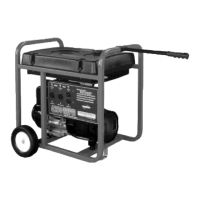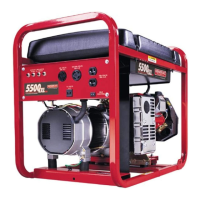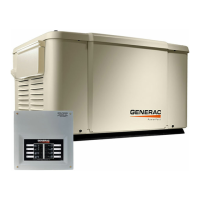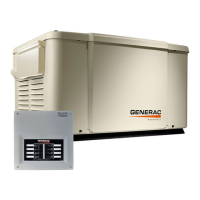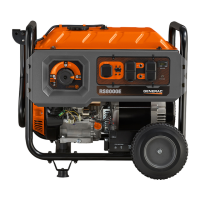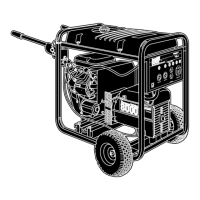Activation and Startup
16 Owner’s Manual for Stationary Diesel Generators
5. Use an accurate AC voltmeter to check utility
power source voltage across transfer switch
terminals N1, N2, and N3 (if three phase). Normal
line-to-line voltage should be equivalent to rated
unit voltage.
6. Check utility power source voltage across
terminals N1, N2, and N3 (if three phase) and the
transfer switch neutral lug.
7. When certain that utility supply voltage is
compatible with transfer switch and load circuit
ratings, turn OFF the utility power supply to the
transfer switch.
8. Press MANUAL on the control pad to crank and
start the engine.
9. Allow the engine to warm up for about five minutes.
Move the Main Circuit Breaker switch on the
generator control panel up to the ON (or closed)
position.
10. Connect an accurate AC voltmeter and a
frequency meter across transfer switch terminal
lugs E1, E2, and E3 (if three phase).
11. Successively connect the AC voltmeter test leads
across terminal lugs E1, E2, and E3 (if three
phase) and neutral; then across E2 and neutral.
Voltage reading in each case should match utility
voltage reading. If system is three phase, verify
that generator phase rotation matches utility phase
rotation.
12. Move the Main Circuit Breaker switch on the
generator control panel down to the OFF (Open)
position.
13. Press OFF on the control pad to shut the engine
down.
IMPORTANT NOTE: Do not proceed unless certain that
generator AC voltage and frequency are correct and
within the stated limits.
Test Generator Under Load
To test the generator set with electrical loads applied,
proceed as follows:
1. Verify that the generator is OFF. A red LED on the
control pad illuminates to confirm that the system is
in the OFF mode.
2. Turn OFF all breakers/electrical loads that will be
powered by the generator.
3. Turn OFF the utility power supply to the transfer
switch, using the means provided (such as a utility
main line circuit breaker).
4. Manually set the transfer switch to the STANDBY
position, i.e., load terminals connected to the
generator’s E1, E2, and E3 (if three phase)
terminals.
5. Press MANUAL on the control pad. The engine will
crank and start.
6. Allow the engine to warm up for a few minutes.
7. Move the Main Circuit Breaker switch on the
generator control panel up to the ON (or closed)
position. The switch is now powered by the
standby generator.
8. Turn ON the circuit breaker/electrical loads
powered by the generator.
9. Connect a calibrated AC voltmeter and a frequency
meter across terminal lugs E1, E2, and E3 (if three
phase). Voltage should be approximately unit rated
voltage. Check with clamp on amp meter to ensure
unit is not overloaded.
10. Let the generator run at full rated load for 20-30
minutes. Listen for unusual noises, vibration or
other indications of abnormal operation. Check for
oil leaks, evidence of overheating, etc.
11. When testing under load is complete, turn OFF
electrical loads.
12. Move the Main Circuit Breaker switch on the
generator control panel up to the OFF (or open)
position.
13. Allow the engine to run at no-load for 2-5 minutes.
14. Press OFF on the control pad to shut the engine
down. A red LED illuminates to confirm that the
system is in the OFF mode.
Check Automatic Operation
To check the system for proper automatic operation,
proceed as follows:
1. Verify that the generator is OFF. A red LED on the
control pad illuminates to confirm that the system is
in the OFF mode.
2. Install front cover of the transfer switch.
3. Turn ON the utility power supply to the transfer
switch, using the means provided (such as a utility
main line circuit breaker).
(000129)
DANGER
Electrocution. High voltage is present at
transfer switch and terminals. Contact with live
terminals will result in death or serious injury.
(000132)
DANGER
Electrocution. Do not manually transfer under load.
Disconnect transfer switch from all power sources
prior to manual transfer. Failure to do so will result
in death or serious injury, and equipment damage.
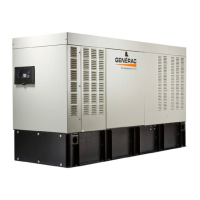
